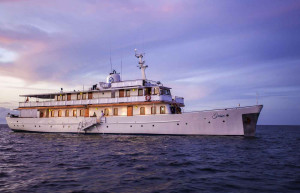Galapagos Islands
For wildlife lovers, the stunning Galapagos are not to be missed.
The astonishment and wonder that Darwin felt when first arriving in the Galapagos Islands almost 200 years ago is still felt today and in this tiny slice of paradise, it’s easy to think you’ve been transported to another world. The creatures are blissfully unaware of how their unique biology and tame nature fascinates and delights every visitor to this remote habitat. Sea lions pose lazily for photos on the white sands, while giant tortoises, penguins and marine iguanas go about their daily lives unperturbed by the cameras clicking nearby. Look to the skies and hawks, boobies, albatross, frigate birds and of course the famous finches are just a few of the many bird species which are resident here. The wildlife is not only abundant on land and in the skies, the underwater world is also teaming with over 400 species of colourful fish, plus sharks, rays and seahorses. Huge whales and playful dolphins regularly visit the islands making this a hotspot for diving and snorkelling. A holiday to Galapagos is best enjoyed on a luxury yacht, allowing exploration between the different islands and rocky outcrops that make up this archipelago. Cruises vary from a few days to two weeks, with most vessels carrying around 16 passengers – meaning each passenger has a truly immersive experience. Full trained naturalist guides are on-board throughout, along with catering staff and crew who will ensure that everything on your trip runs as smoothly as possible. As you journey between the different islands, you will be able to enjoy talks and presentations on the geological make-up of each outcrop, and which species call it home. Living aboard a yacht is by far the most convenient way to travel between the islands, however, for those who would rather have a solid base each night, there is a small selection of luxury hotels and even a luxury tented camp which provide other accommodation options for visitors to the Galapagos.
DISCOVER COUNTRY
WHEN TO VISIT AND FACTS
| Currency | Dollar | |
| Time Zone |
GMT-6 | |
| Language | Spanish |
| Flight Time |
20 hours from London Heathrow | |
| Capital City | Puerto Baquerizo Moreno | |
| National Dish | Fresh seafood and plantain |
January
January is the beginning of the rainy season. Water and air temperatures rise and stay warm until June.
- Ideal time for snorkeling as there is great underwater visibility.
- Land birds and frigate birds are nesting.
- Land iguanas begin their reproductive cycle.
- The green sea turtles arrive on the beaches for their egg-laying period.
February
February is the month where the water reaches its highest temperature, which remains constant until April.
- February is still a great time for snorkeling with warm waters and good visibility.
- Marine iguanas are nesting.
- First sightings of penguins after having followed the cool waters back to the west.
- Nesting season of the galapagos dove has reached its peak.
- Giant tortoises are hatching.
March
Rainy season reaches the highest precipitation in March with sporadic tropical rains. Temperatures remain hot with high humidity.
- Snorkeling remains a major activity as visibility is still clear.
- It’s the marine iguana nesting season.
- Penguins are still active in the water, swimming around with tropical fish.
- Hatching season of giant tortoise’s eggs continues.
April
In April the rains have ended and the islands are very green. Both the water and air temperatures are at their best.
- The beginning of the best two months for snorkeling.
- The start off the mating dance for the blue-footed boobies.
- End of hatching season for the giant tortoises.
- Eggs of green sea turtles begin to hatch.
- Eggs of land iguanas begin to hatch.
May
Water and air temperatures remain at their peak in May. Along with June, these months offer the most pleasant weather.
- Blue-footed boobies have their courtship.
- Most marine iguanas hatch from their nests.
- Band-rumped storm petrels begin their first nesting period.
- Magnificent and great frigate birds are nesting (all year round).
June
Beginning of the garúa season (cool dry season) which lasts until December. South-east winds return, currents become a bit stronger and seas pick up in surge and wave action.
- Giant tortoises migrate from the highlands to the lowlands and begin their nesting season.
- Magnificent frigate birds show off their red pouches.
- Southern migrants have started their journey journey towards the north and Galapagos provides a resting spot.
- Groups of humpback whales begin to appear.
July
Water temperatures start dropping down in July and this month has more pronounced winds.
- The presence of the Humboldt Current begins to strengthen making nutrients in the water more abundant and marine life more active.
- Flightless cormorants perform beautiful courtship rituals and nesting activities.
- Lava lizards initiate mating rituals until November.
- Cetaceans (whales and dolphins) are more likely to be seen.
- Great month to see the four stages of nesting in blue-footed boobies: eggs, chicks, juveniles and sub-adults.
August
In August, the temperature of the ocean drops and they begin to get quite choppy. Currents reach their strongest levels and a surge can be expected along the shores that face south or west.
- Giant tortoises return to the highlands.
- Migrant shore birds start to arrive staying on the islands until March.
- Pupping season of sea lions has started. Western and central islands are common places to see such sightings.
- Dolphin and whale sightings are likely with the cool oceanic Humboldt Current arriving from the south.
September
The air temperatures reach their lowest in September but with the lowest chance of rain in the lowlands.
- A great month for snorkeling.
- Galapagos Penguins show remarkable activity in the water.
- Sea lions are very active. Females have reached their estrus stage so harem-gathering males are constantly barking and fighting.
- Most species of sea birds remain active at their nesting sights.
October
Days are not always sunny but the drizzle rain surrounds the volcanoes making the islands ‘disappear’ from sight. Afternoons tend to clear making day activities and programs not affected.
- Blue-footed boobies raise their chicks.
- Lava herons start nesting until March.
- The Galapagos fur sea lions begin their mating period.
- Giant tortoises are still laying their eggs.
November
Seas are much calmer in November and their temperatures are beginning to rise again. The Humboldt Current is still strong meaning marine life is still very active.
- Breeding season for the brown noddies.
- Marine encounters are very common so snorkeling is at its peak.
- Band-rumped storm petrels begin their second nesting period.
- Pupping of sea lions continues and sea lion pups play aqua-aerobics next to snorkelers and even tend to nibble on fins.
December
In December, the rainy season begins though great weather remains, with mostly sunny days. Water temperatures continue to warm up.
- Its the start and the end of the breeding and mating seasons for many animals, making wildlife very attractive.
- Hatching of giant tortoise’s eggs.
- Green sea turtles begin their mating behaviour.
- First red pouches of great frigate birds seen.
- The first young albatrosses fledge.
- Northern migrants have started their journey south, stopping by the Galapagos.
FAQs
How do I know if the Galapagos is the right destination for me?
Galapagos is a great destination for almost everyone. Nature lovers will appreciate a transformative experience with wildlife and a first-hand view of how islands form. Adventure lovers will enjoy the countless activities, hikes and experiences available. And it’s the perfect opportunity for honeymooners or families to escape from everyday life and find quality time. If you’re looking for a conventional beach destination, top shopping, and traditional entertainment options, this is probably not for you.
When do I need to book?
In short, it’s a case of ‘the earlier the better’. To be confident of securing your first choice cruise, you need to be booking at least 6 – 9 months in advance.
How do I get to the Galapagos?
All international flights coming to Ecuador will stop directly at either Mariscal Sucre International Airport (Quito) or José Joaquín de Olmedo International Airport (Guayaquil). If you are changing flights from Quito to Galapagos, you will have a mandatory stop in Guayaquil. If you travel directly to Guayaquil, you will fly directly to the Galapagos. Depending on your departure date and itinerary, you will be landing in the Galapagos at either Baltra Airport or San Cristobal airport.
When should I go?
The good thing about the Galapagos Islands is that they can be visited all year long. During both hot and dry season, the Galapagos wildlife is always on display. Choosing a time to go really depends on your interests. Hot season, for example, is the breeding season for land birds and iguanas. This means that there’s a lot of activity in the realm of winged and terrestrial species. The dry season, with its nutrient rich waters, attracts plenty of aquatic species and seabirds (including penguins!).
How do I choose the right ship?
This is an important question. There’s an exciting selection of Galapagos cruises to choose from ranging from 4 – 14 days in duration. Check out our cruises list available above or contact us to speak to our specialists about the ships on offer and how they differ.
What wildlife will I see?
Wildlife lies at the heart of every Galapagos trip, and no mater when you travel, you’ll be sure to see plenty of species. For an in-depth breakdown, check out the monthly guide above to find out which animals you are likely to see at each time of the year.
What activities are available?
A varied range of activities are offered to visitors both on land and on cruise ships. Most tastes can be met, from sports like snorkeling, diving, kayaking, hiking, cycling, swimming and surfing, etc. to walks along the beach, shopping and dining out.




